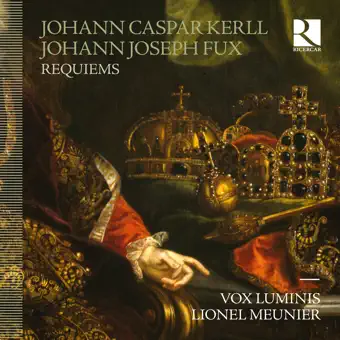november 2016
Kerll & Fux: Requiems
Vox Luminis o.l.v. Lionel Meunier
De prijs voor Opname van het Jaar 2012 voor hun Schütz-cd trok terecht de aandacht naar dit fantastische koor; deze nieuwste release voor Ricercar is net zo kundig en meeslepend.

Kerlls Missa pro defunctis (uitgegeven in 1689) was opgedragen aan keizer Leopold I, en het voorwoord onthult dat de componist wilde dat het werd uitgevoerd tijdens zijn eigen begrafenis. Vox Luminis' volmaakte beheersing van polyfone texturen, klagende klanken en gecontourde frasering is diepgaand mooi; de vijf solisten en vijf extra 'ripieno'-zangers declameren de tekst met helderheid en decorum. Een organist en het vierstemmige gambaconsort L'Achéron verdubbelen vaak de stemmen, maar spelen soms onafhankelijke concertante-partijen, zoals de trillende begeleiding van 'Quantus tremor' (een trillende bassolo), een fanfare-achtige aanval op gestippelde ritmes tijdens 'Tuba mirum' (een tenorsolo), en welluidende aanhoudende lijnen en discreet gevormde suspensies ter ondersteuning van 'Mors stupebit' (een altsolo) en 'Lacrimosa' (een korte sopraansolo). In contrapuntische koren – of het nu gaat om het snel bewegende detail van ‘Quam olim Abrahae’ of de ontvouwende sereniteit van ‘Lux aeterna’ – is de combinatie van alle 15 muzikanten plechtig meelevend.
Fux’ Requiem werd uitgevoerd bij de begrafenis van de weduwe-keizerin Eleonore Magdalena van Neuburg (weduwe van Leopold I) in 1720, en kreeg daarna de bijnaam Kaiserrequiem omdat het nieuw leven werd ingeblazen voor de uitvaart van Karel VI in 1740. Fux’ beroemde vaardigheid in contrapunt is ook expliciet in ritornellen die af en toe voorkomen – meestal voor twee violen, altviool en basso continuo, maar Mozartianen zullen het gebruik van solo-trombone opmerken in ‘Tuba mirum’ (een altsolo); in grotere passages verdubbelen de instrumentalisten van Scorpio Collectief het koor met twee gedempte cornetten, twee trombones en fagot. De verbonden korte bewegingen in de Sequence laten een mooie vloeiendheid zien tussen de ‘Recordare’ (een solokwartet) en het daaropvolgende ‘Quaerens me’ (een volledig ensemble dat zachtjes weeft); een elegant klein trio voor twee sopranen en alt (‘Inter oves’) gaat over in een donkerder getinte koorzang ‘Confutatis’. Polyfone strengen stijgen in boogvormige frasen in het genuanceerde ‘Sanctus’, en een naadloze progressie van suspensies en resoluties van boven naar beneden in de muzikale textuur rondt een troostende ‘Communio’ af. Een alternatieve opname van het Kaiserrequiem door Roland Wilsons Musica Fiata en La Capella Ducale heeft een meer uitgesproken ritmisch clair-obscur, maar is vocaal ongelijkmatig, terwijl de verfijning van Vox Luminis nooit minder dan subliem is.

Kerll’s Missa pro defunctis (published 1689) was dedicated to Emperor Leopold I, and its preface reveals that the composer wanted it performed at his own funeral. Vox Luminis’s consummate mastery of polyphonic textures, plangent sonorities and contoured phrasing is profoundly beautiful; the five soloists and five additional ‘ripieno’ singers declaim text with clarity and decorum. An organist and the four-part viol consort L’Achéron often double the voices but sometimes play independent concertante parts, such as the quivering accompaniment to ‘Quantus tremor’ (a tremulous bass solo), a fanfare-like attack to dotted rhythms during ‘Tuba mirum’ (a tenor solo), and mellifluous sustained lines and discreetly shaped suspensions in support of ‘Mors stupebit’ (an alto solo) and ‘Lacrimosa’ (a brief soprano solo). In contrapuntal choruses – whether the quick-moving detail of ‘Quam olim Abrahae’ or the unfurling serenity of ‘Lux aeterna’ – the combination of all 15 musicians is solemnly compassionate.
Fux’s Requiem was performed at the funeral of the Dowager Empress Eleonore Magdalene of Neuburg (widow of Leopold I) in 1720, and thereafter acquired the nickname Kaiserrequiem because it was revived for the obsequies of Charles VI in 1740. Fux’s famed skill at counterpoint is also explicit in ritornellos that occur occasionally – usually for two violins, viola and basso continuo, but Mozartians will notice the use of solo trombone in ‘Tuba mirum’ (an alto solo); in larger-scale passages the instrumentalists of Scorpio Collectief double the choir with two muted cornets, two trombones and bassoon. The connected short movements in the Sequence present a lovely fluidity between the ‘Recordare’ (a solo quartet) and the ensuing ‘Quaerens me’ (full ensemble weaving gently); an elegant little trio for two sopranos and alto (‘Inter oves’) proceeds into a darker-hued choral ‘Confutatis’. Polyphonic strands rise in arching phrases in the nuanced ‘Sanctus’, and a seamless progression of suspensions and resolutions from top to bottom of the musical texture caps off a consoling ‘Communio’. An alternative recording of the Kaiserrequiem by Roland Wilson’s Musica Fiata and La Capella Ducale has more pronounced rhythmical chiaroscuro but is vocally uneven, whereas the refinement of Vox Luminis is never anything less than sublime.
